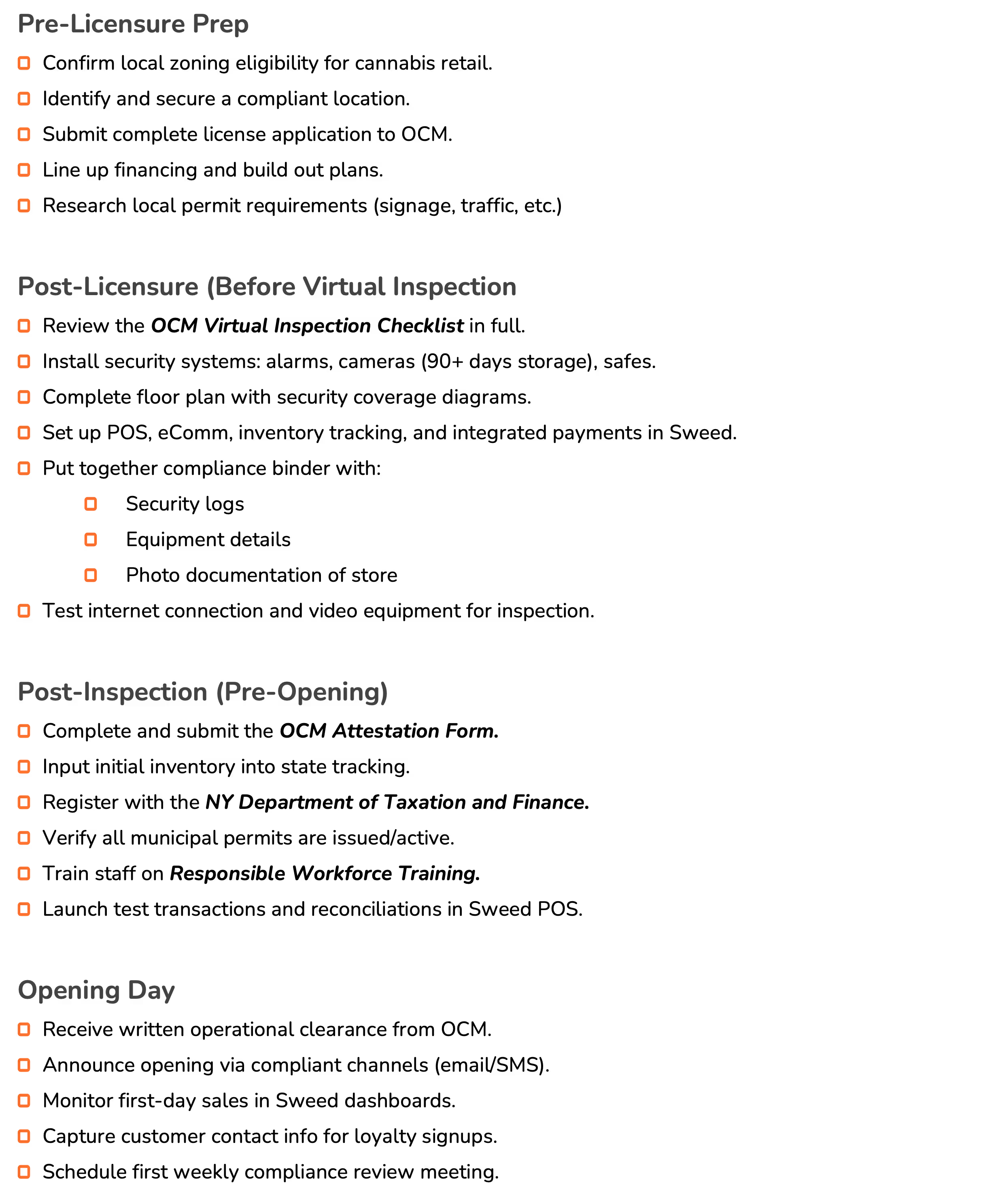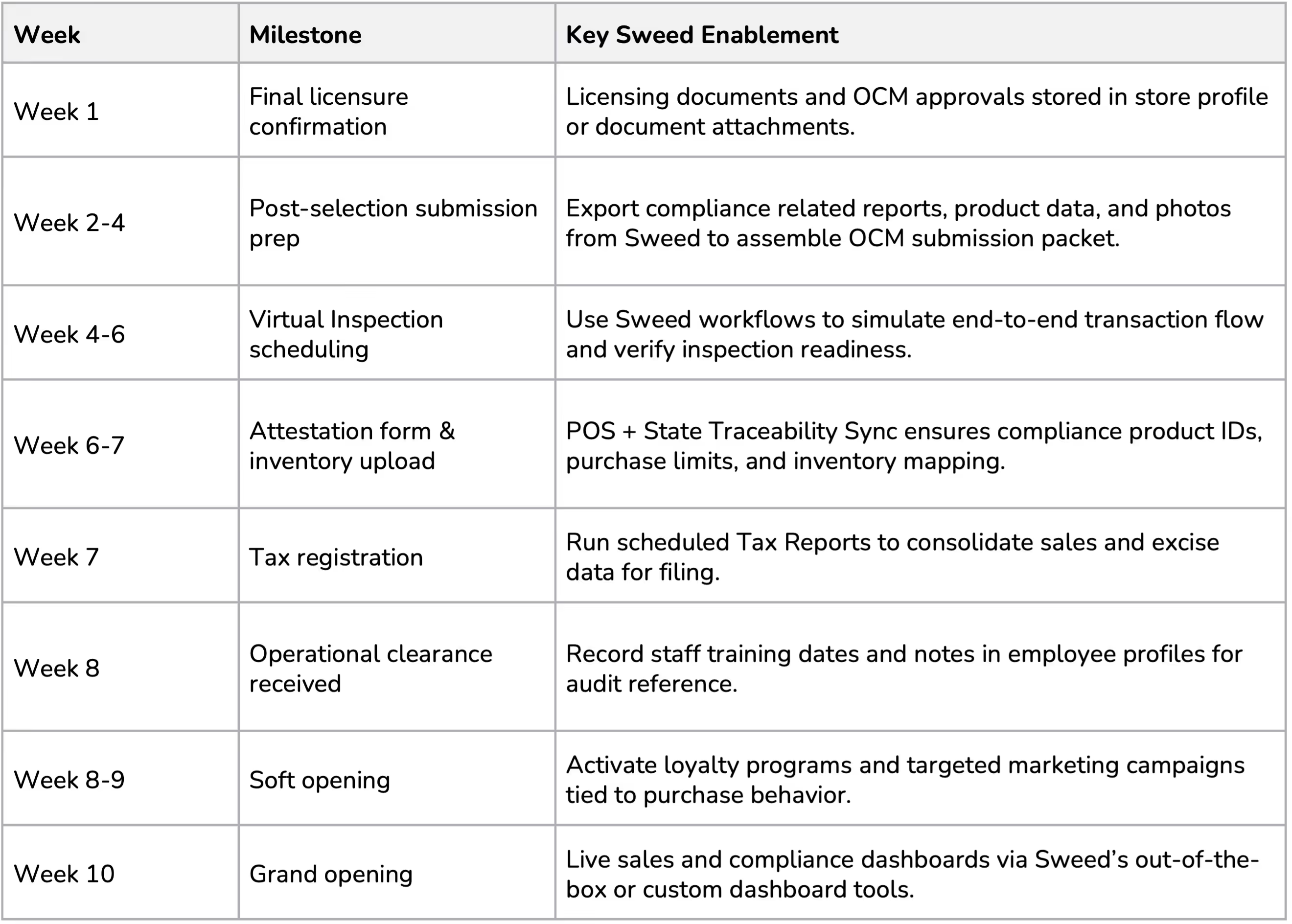Congratulations! Securing a New York adult-use retail cannabis license is a huge milestone. But now the real work begins.
New York’s cannabis industry is regulated by the Office of Cannabis Management (OCM), and every operator must follow strict operational, security, and reporting requirements before opening their doors.
This guide is designed to:
- Translate the OCM Adult-Use Retail Compliance Welcome Packet into clear, actionable steps.
- Integrate operational best practices from top cannabis retailers.
- Highlight where Sweed’s platform can streamline compliance, improve efficiency, and help you operate profitably.
The goal: by the end of the guide, you’ll have a clear operational roadmap from licensing to launch day and beyond!
A Look Into Today’s Market
The market is crowded, competitive, and compliance-heavy. The difference between thriving and just surviving comes down to how well you execute your launch, run your operations, and build customer loyalty from day one.
What to Avoid:
- Stitched-together tools that don’t talk to each other.
- Manual compliance work that eats up staff hours.
- Generic marketing that customers ignore.
- Blind spots in operations, inventory, and customer behavior.
What to Choose:
- One platform that runs your store end-to-end, POS, eCommerce, loyalty, marketing, inventory, compliance, all built together, not bolted on.
- AI-powered data that turns every customer interaction into a growth opportunity.
- Precision marketing that cuts through the noise and drives real revenue.
- Operator-first workflows that make compliance, reporting, and daily tasks easier.
- Seamless customer experiences that elevate your brand at every touchpoint.
- A partner who stays with you long after onboarding.
Understanding the Compliance Landscape
Key Principles
- Licensure is conditional until fully approved: Board approval gives you provisional status. But you can’t sell or accept products until all post-selection steps are complete.
- OCM compliance is layered: You’ll deal with state requirements (OCM, Dept. of Taxation and Finance) and local requirements (zoning, building permits, signage).
- Regulations evolve: Stay subscribed to OCM updates, as guidance can change even after your license is issued.
Sweed Tip: Sweed’s Advance Reports and Saved Reports tools can be configured to track compliance-critical data points, such as staff training completion, daily sales by category, or tax liabilities, so operators always have documentation ready for inspectors.
OCM Requirements
A clear sequence from license award to sales
- Final Licensure – Board approval & clearance from Licensing Unit.
- Post-Selection Submission – Required docs for virtual inspection.
- Virtual Inspection – Live video walkthrough with Compliance Inspector.
- Attestation & Initial Inventory – Confirm readiness and input products into the state system.
- Tax & Finance Registration – Set up to collect sales and excise tax.
- Operational Clearance – Written approval to start selling.
What They Don’t Tell You
- Local approvals can make or break your timeline. Zoning, signage, and DOB permits (especially in NYC) must be in place.
- Waiting until inspection week to get your systems in order will cost you time and revenue.
Sweed Advantage: Compliance is built into our platform from day one. You don’t juggle multiple vendors or spreadsheets. Inspections, reporting, and daily compliance tasks are integrated into the same system you use to sell, market, and manage inventory.
From License to Launch: The NY Operator Roadmap
The OCM packet outlines a clear process. Below, we’ve expanded each step with additional insight, risks to watch for, and Sweed use cases.
Step 1 – Confirm Final Licensure
- Receive your Board approval notification and verify with the Licensing Unit.
- Ensure no outstanding issues with ownership disclosures, background checks, or prior municipal objections.
Sweed Tools: Store licensing documents and approvals securely in Sweed’s Document Management within customer or store profiles, linked to location and date for quick retrieval.
Step 2 – Post-Selection Submission
- Prepare all required documentation for the Virtual Inspection Checklist:
- Floor plans
- Security camera coverage diagrams
- Storage areas
- Product display cases
- Alarm system details
- Safe specifications
- Submit in the exact format OCM requests – no Google Drive/Dropbox links.
Best Practice: Compile as a single indexed PDF for faster OCM review.
Sweed Tools: Upload and tag compliance photos, equipment lists, and schematics in Sweed so they’re searchable by keyword, store, or license ID.
Step 3 – Virtual Inspection Prep
- OCM will assign a Compliance Inspector to review your materials and schedule a video walkthrough.
- Your store must be fully operational, including furniture, fixtures, and security systems installed.
- All entrances/exits, restricted areas, and point-of-sale terminals must be shown live.
Tips for Success:
- Test your internet connection – inspections fail if video drops.
- Have a second staff member present to operate cameras while you narrate.
Sweed Tools: Use Sweed’s Sections view to simulate operational workflows, from customer check-in to completed transaction, so staff are inspection-ready.
Step 4 – Attestation & Initial Inventory
- Complete and submit the OCM Attestation Form – confirming readiness to comply with all rules.
- Enter your initial inventory into the state’s tracking system.
Sweed Tools: Sweed’s POS + State Traceability Sync supports compliant product IDs, batch details, and purchase limits at checkout, minimizing manual entry errors.
Step 5 – Tax & Finance Registration
- Register with the NY Department of Taxation and Finance for sales tax and excise tax collection.
- Set up regular filling reminders.
Sweed Tools: Run scheduled Tax Reports in Sweed to export sales and excise data in one step. No manual reconciliations needed.
Step 6 – Opening Day
- Only begin sales after receiving written operational clearance.
- Have all staff trained in OCM-approved Responsible Workforce Training.
Sweed Tools: Use Customer Profiles + Staff Notes to document training completion and renewal dates, visible to managers and auditable.
Local Compliance: Navigating Municipal Rules
Navigating local compliance is just as important as meeting OCM requirements. It can impact your opening timeline, customer experience, and bottom line. Across New York State.
Municipal specifications to consider:
- Zoning Restrictions – Many towns and cities enforce strict zoning for cannabis retail, including distance buffers from schools, parks, churches, or other dispensaries.
- Signage Limitations – Municipal codes often restrict the size, lighting, placement, or even colors of storefront signs beyond what OCM regulates.
- Parking & Traffic Impact Requirements – Local boards may require traffic flow studies, parking minimums, or congestion-mitigation plans before granting approvals.
- Health & Safety Inspections – County health departments may require additional inspections for HVAC systems, air filtration, or sanitation.
- Historic District Considerations – In certain areas, building modifications, exterior paint colors, or signage styles must meet preservation guidelines.
- Operating Hour Restrictions – Some municipalities impose earlier closing times or limit hours of operation on weekends/holidays.
- Community Board Input – Especially in larger cities, local advisory boards or councils may have nonbinding but influential opinions on your application and operations.
- Noise & Lighting Ordinances – Outdoor lighting levels, illuminated signs, and amplified sound may be regulated to minimize neighborhood impact.
NYC Example: The Department of Buildings (DOB) requires specific permits for cannabis retail buildouts, often through the DOB NOW portal.
Operational Best Practices
Security
- Use multi-layered security: cameras + alarms + panic buttons.
- Keep 90+ days of camera footage, even if OCM minimums are lower.
Sweed Tools: Use Notes & Attachments on store profiles to log security system checks and upload compliance evidence.
Inventory Control
- Conduct daily reconciliations to prevent discrepancies.
- Keep expired/damaged product logs separate from sellable inventory.
Sweed Tools: Sweed’s Automated Variance Reports flag mismatches between POS and state tracking instantly.
Staff Training
- Go beyond OCM minimums: train on customer experience, upselling, and ID verification best practices.
Sweed Tools: Create training segments in Sweed’s Marketing > Segments to send role-specific training reminders via SMS or email.
Marketing & Promotions
- Follow OCM advertising restrictions, including not targeting individuals under 21, and not including any health claims.
- Leverage in-store experiences to build brand loyalty.
Sweed Tools: Sweed’s Discount Engine ties promos directly to POS and eCommerce – no double entry – and supports vendor-fueled programs.
Built to Grow With You, Not Just Run Your Store.
Sweed isn’t just cannabis retail software. It’s your growth engine.
From your first inspection to your 500th customer, we help you run better, sell smarter, and stay compliant every step of the way.
- Grow Your Reach – Run compliant campaigns across SMS, email, and push, targeted by behavior and purchase history.
- Elevate the Experience – Real-time menus, frictionless checkout, personalized loyalty.
- Speed Up Sales – Integrated payments, faster lines, reduced cash risk.
- Fulfill with Confidence – Perfect orders, every time.
- Maximize Customer Value – Upsell smartly with AI recommendations.
- Drive Repeat Business – Retention journeys, rewards, easy reorders.
Why it Works: Because your data, operations, marketing, and compliance live in one system, every part of the flywheel is connected, and every customer interaction can turn into more revenue.
Why New York Operators Choose Sweed
- Built for cannabis from day one.
- True all-in-one platform – no Frankenstack.
- Single data layer for AI-powered personalization.
- Integrated payments to reduce cash risk.
- Compliance baked in, not bolted on.
- Real human support that moves at the speed of retail.
Bonus Resources

Compliance Timelines
Below is a typical launch timeline for a NY cannabis retailer. Actual timing can vary based on inspection readiness and municipal approvals.


%201.svg)